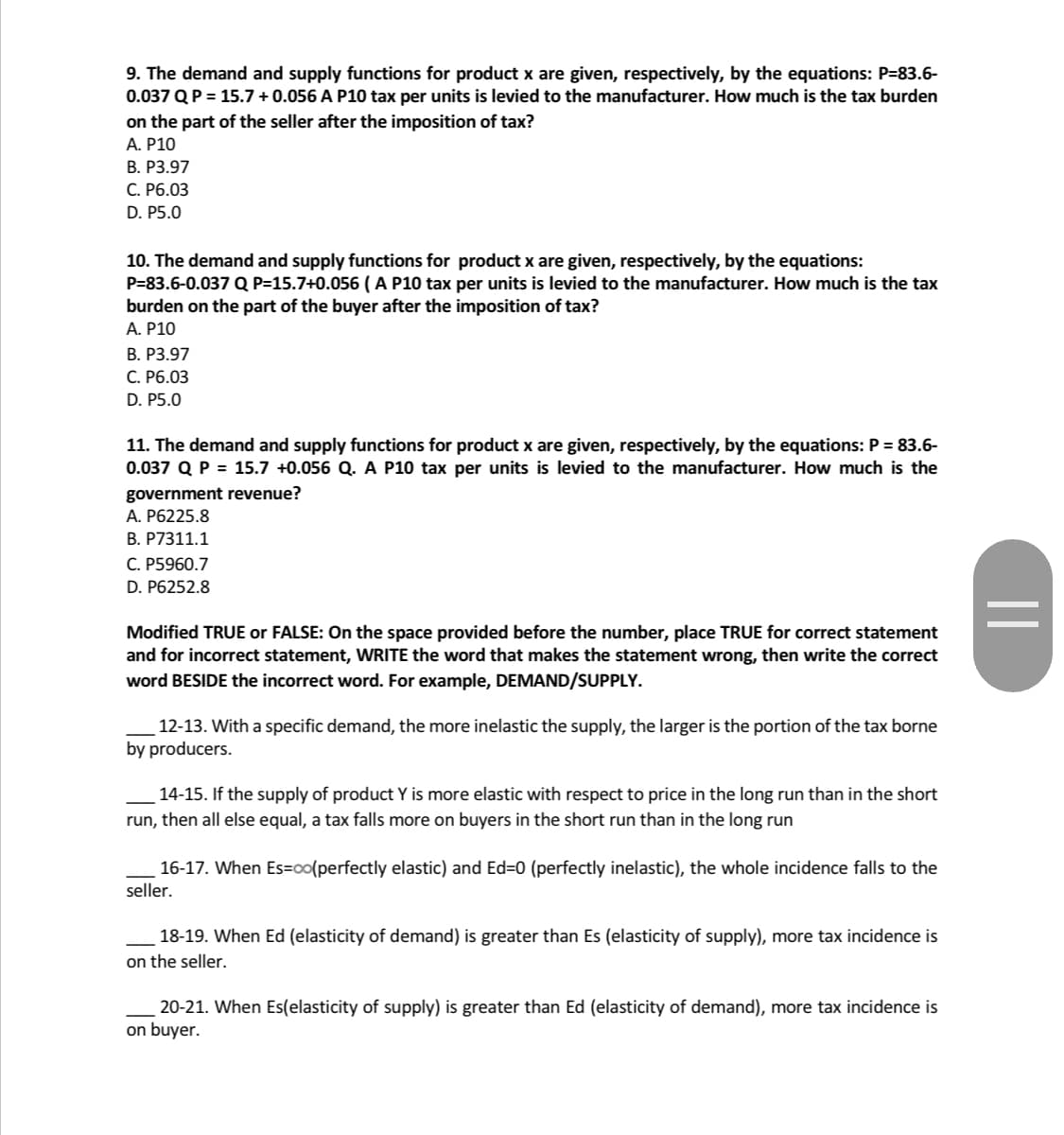9. The demand and supply functions for product x are given, respectively, by the equations: P-83.6- 0.037 Q P = 15.7 + 0.056 A P10 tax per units is levied to the manufacturer. How much is the tax burden on the part of the seller after the imposition of tax? A. P10 B. P3.97 C. P6.03 D. P5.0 10. The demand and supply functions for product x are given, respectively, by the equations: P=83.6-0.037 Q P=15.7+0.056 ( A P10 tax per units is levied to the manufacturer. How much is the tax burden on the part of the buyer after the imposition of tax? A. P10 B. P3.97 C. P6.03 D. P5.0 11. The demand and supply functions for product x are given, respectively, by the equations: P = 83.6- 0.037 Q P = 15.7 +0.056 Q. A P10 tax per units is levied to the manufacturer. How much is the government revenue? A. P6225.8 B. P7311.1 C. P5960.7 D. P6252.8
9. The demand and supply functions for product x are given, respectively, by the equations: P-83.6- 0.037 Q P = 15.7 + 0.056 A P10 tax per units is levied to the manufacturer. How much is the tax burden on the part of the seller after the imposition of tax? A. P10 B. P3.97 C. P6.03 D. P5.0 10. The demand and supply functions for product x are given, respectively, by the equations: P=83.6-0.037 Q P=15.7+0.056 ( A P10 tax per units is levied to the manufacturer. How much is the tax burden on the part of the buyer after the imposition of tax? A. P10 B. P3.97 C. P6.03 D. P5.0 11. The demand and supply functions for product x are given, respectively, by the equations: P = 83.6- 0.037 Q P = 15.7 +0.056 Q. A P10 tax per units is levied to the manufacturer. How much is the government revenue? A. P6225.8 B. P7311.1 C. P5960.7 D. P6252.8
Managerial Economics: Applications, Strategies and Tactics (MindTap Course List)
14th Edition
ISBN:9781305506381
Author:James R. McGuigan, R. Charles Moyer, Frederick H.deB. Harris
Publisher:James R. McGuigan, R. Charles Moyer, Frederick H.deB. Harris
Chapter3: Demand Analysis
Section: Chapter Questions
Problem 11E: Federal excise taxes on gasoline vary widely across the developed world. The United States has the...
Related questions
Question
100%

Transcribed Image Text:9. The demand and supply functions for product x are given, respectively, by the equations: P=83.6-
0.037 Q P = 15.7 + 0.056 A P10 tax per units is levied to the manufacturer. How much is the tax burden
on the part of the seller after the imposition of tax?
A. P10
B. P3.97
C. P6.03
D. P5.0
10. The demand and supply functions for product x are given, respectively, by the equations:
P=83.6-0.037 Q P=15.7+0.056 (A P10 tax per units is levied to the manufacturer. How much is the tax
burden on the part of the buyer after the imposition of tax?
A. P10
B. P3.97
C. P6.03
D. P5.0
11. The demand and supply functions for product x are given, respectively, by the equations: P = 83.6-
0.037 Q P = 15.7 +0.056 Q. A P10 tax per units is levied to the manufacturer. How much is the
government revenue?
A. P6225.8
B. P7311.1
C. P5960.7
D. P6252.8
Modified TRUE or FALSE: On the space provided before the number, place TRUE for correct statement
and for incorrect statement, WRITE the word that makes the statement wrong, then write the correct
word BESIDE the incorrect word. For example, DEMAND/SUPPLY.
12-13. With a specific demand, the more inelastic the supply, the larger is the portion of the tax borne
by producers.
14-15. If the supply of product Y is more elastic with respect to price in the long run than in the short
run, then all else equal, a tax falls more on buyers in the short run than in the long run
16-17. When Es=co(perfectly elastic) and Ed=0 (perfectly inelastic), the whole incidence falls to the
seller.
18-19. When Ed (elasticity of demand) is greater than Es (elasticity of supply), more tax incidence is
on the seller.
20-21. When Es(elasticity of supply) is greater than Ed (elasticity of demand), more tax incidence is
on buyer.
||
Expert Solution
This question has been solved!
Explore an expertly crafted, step-by-step solution for a thorough understanding of key concepts.
Step by step
Solved in 6 steps

Knowledge Booster
Learn more about
Need a deep-dive on the concept behind this application? Look no further. Learn more about this topic, economics and related others by exploring similar questions and additional content below.Recommended textbooks for you

Managerial Economics: Applications, Strategies an…
Economics
ISBN:
9781305506381
Author:
James R. McGuigan, R. Charles Moyer, Frederick H.deB. Harris
Publisher:
Cengage Learning


Managerial Economics: Applications, Strategies an…
Economics
ISBN:
9781305506381
Author:
James R. McGuigan, R. Charles Moyer, Frederick H.deB. Harris
Publisher:
Cengage Learning
